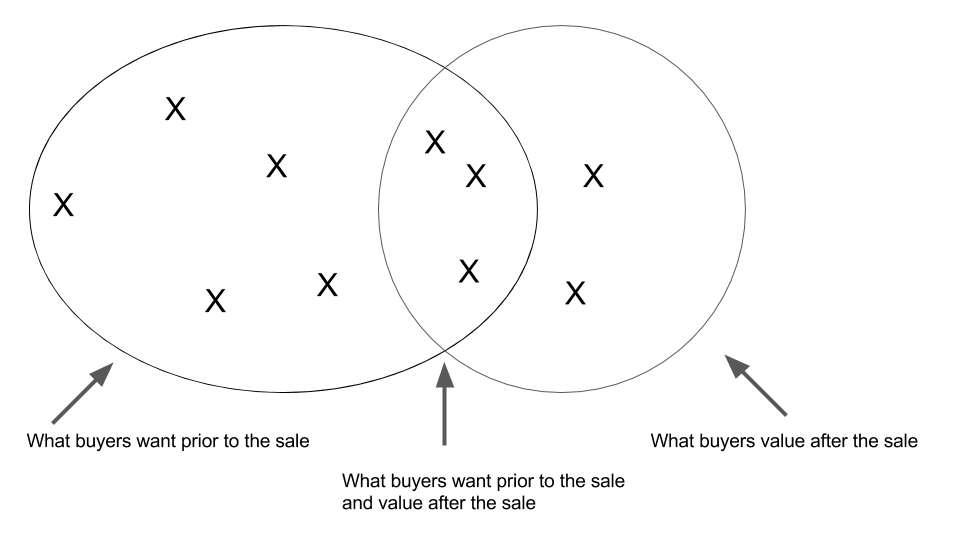The Product Manager's Visual Guide to Feature Selection
Sunday, June 4, 2017
I'm going to dispense with my usual diatribe on features vs. benefits. It's been done to death - both on my blog and elsewhere on the internet.
Let's spend some time just focusing on feature selection.A Generic Feature Set
Here's a Venn diagram that depicts a feature set for a given product.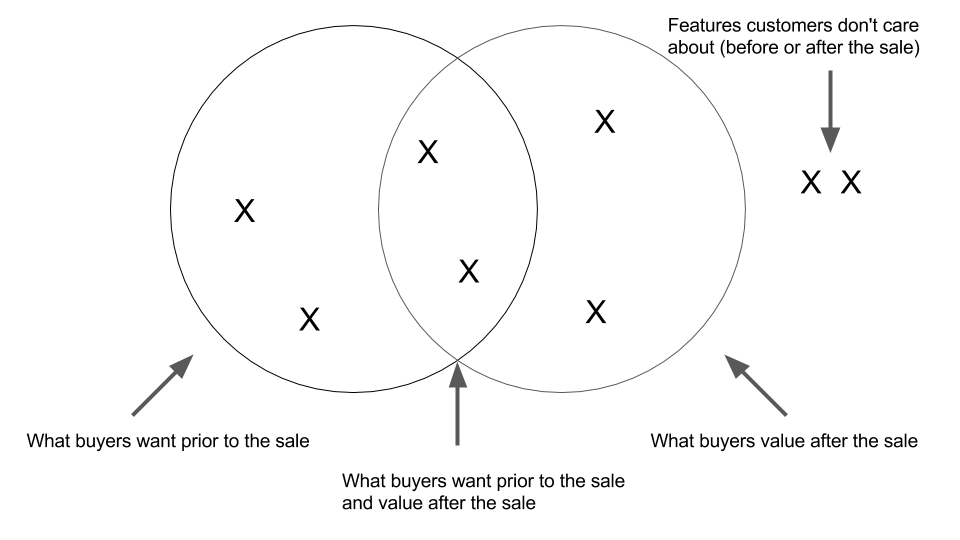
- The circle on the left represents all of the product's features that matter to a consumer prior to purchase.
- The circle on the right represents everything that a buyer realizes are important at some point after his purchase.
It should be noted that the two circles do overlap.
There are some features that a consumer will want prior to purchase and be thrilled to have after purchase. When I bought my car, I certainly wanted one with a steering wheel. To this day, I'm still happy with the fact that my car has one.
Unfortunately, the two circles do not completely overlap. This usually comes down to customers' lack of prior knowledge, insight and experience with a given product. A novice buyer of a wooden sailboat, for instance, may value the look of a wooden exterior, yet after purchase may come to learn that wood requires substantially more maintenance and attention than fiberglass.
Finally, it should be noted that every product is going to wind up having a collection of features that no buyer will ever care about. Those types of features often represent wasted effort and should be avoided if possible. For the sake of simplicity, we'll ignore them, as no one would intentionally add such features (barring cases of regulation, corruption, or other external pressures).An Engineer's Feature Set
In an ideal world, a vendor would simply focus on maximizing the value that a customer receives from his product. Unfortunately, we do not live in an ideal world. This fact often comes as a surprise to many business owners (especially those with an engineering mindset) when launching a new product.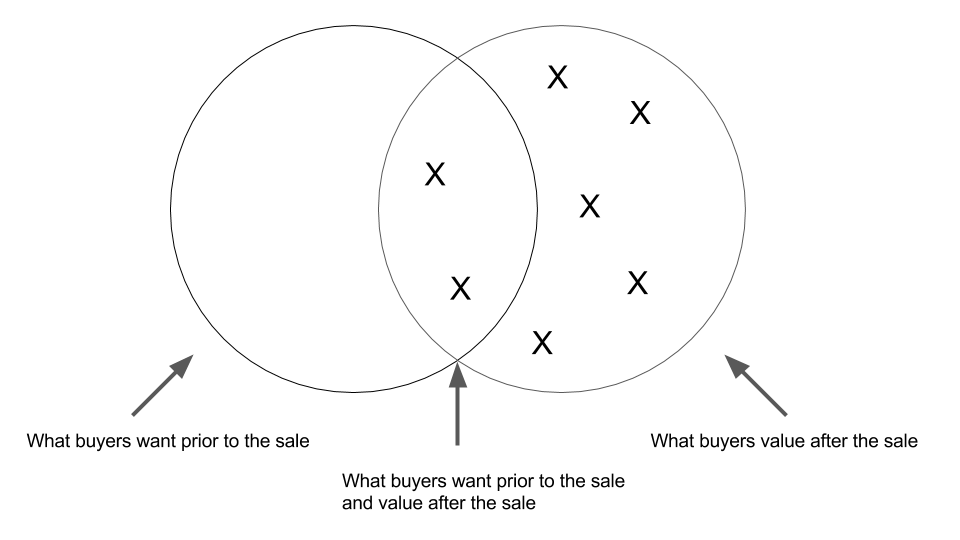
In the abstract, focusing on what would make a customer happy appears to be a great approach. Maximizing customer value sounds honest (which it is) and appears to be a surefire recipe for success (which it isn't). As we saw in the evolution of a variety of animals such as the fiddler crab, what the buyer finds attractive often makes little to no sense. In many cases, buyers will not have any good method to evaluate the value that a purchase will provide.
Focusing purely on long term value, without considering whether that value will be recognized on a reasonable time scale, may reduce the interest of potential customers - especially in the short term. Products with a feature set selected primarily with an eye to customer value will have significantly less pricing power because they won't necessarily meet many of the criteria that customers may be selecting for. Not only that, but the inclusion of potentially pricey features that go unappreciated at time of sale may force higher prices and result in sticker shock for customers. In some cases, the value of a worthwhile feature might not be apparent until months or even years have passed. Just think about the value of safety enhancements in a car. The value of an airbag is often forgotten until a driver finds himself walking away from his vehicle after a head-on collision.
Companies selecting this type of feature set will only thrive when they have the freedom to focus on long term relationships with repeat buyers. Their consumers may not understand the value of features delivered, but will come to trust the brand anyway, knowing that it has their best long term interests at heart.A Scammer's Feature Set
The opposite of the previous approach is to include only the features that will result in sales - consequences be damned. This generally results in an extreme focus on bells and whistles while any functionality that isn't on a buyer's mental checklist is ignored. Such methodology can be a powerful technique for gaining attention from customers, journalists and others who lack a certain familiarity with the product being sold.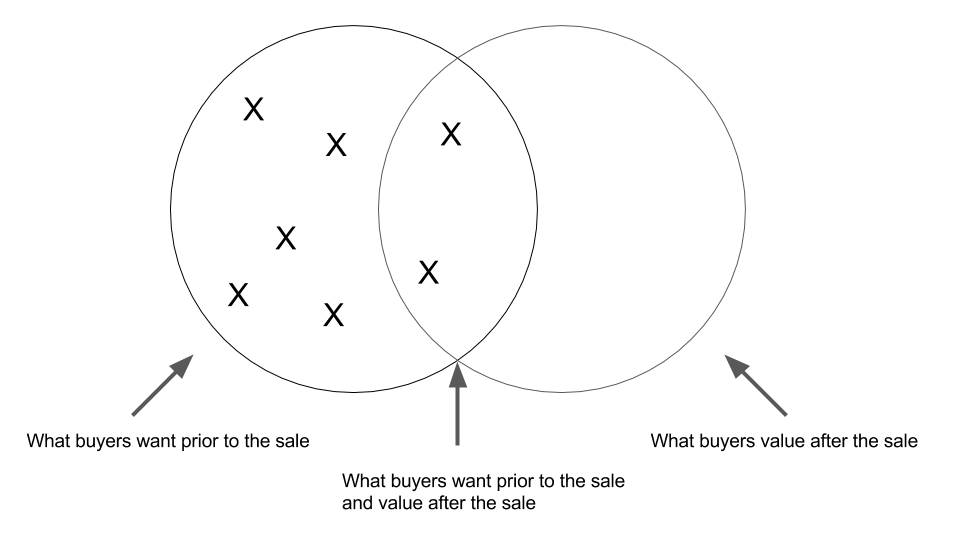
In a previous article I pointed to one of my favorite companies (Theranos). It earned plenty of praise in the press for its variety of blood tests, despite the fact that a small problem had long gone unnoticed. Its tests posed an immediate jeopardy to patient health and safety. Oops.
In any case, focusing purely on pre-purchase wants rather than post-purchase values can prove enormously profitable. This is especially true in markets with relatively low levels of brand recognition and few barriers to entry. If you have no scruples about how you earn your money, and you know the list of countries that lack extradition treaties with the US, this can be a very powerful means of earning enormous profits with very little effort. A clever marketer can pick flashy features that look desirable and are often very cheap to implement - especially when providing actual value is not a matter of particular interest.
Sure, buyers will suffer terrible remorse, and likely curse you family for umpteenth generations, but hey, you can't argue with success.An Ideal Feature Set
Most businesses will come to realize that they can't follow the engineer's approach - it's just too difficult to outcompete the scammers. Of course, they can't just act like scammers either. Whether due to a misguided sense of honesty, fear of litigation, or just a desire to maintain a business with a good reputation, they'll have to find a position somewhere in the middle.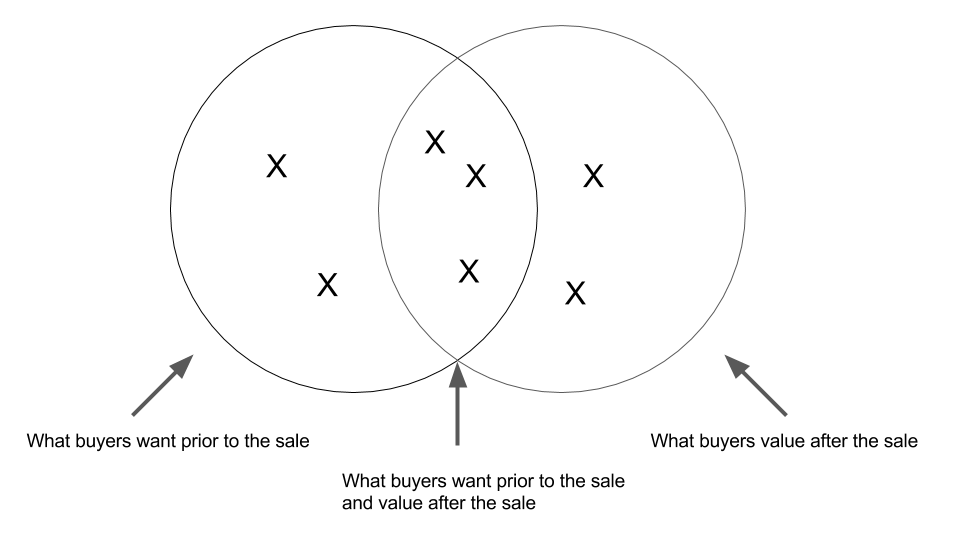
Advice to Honest Businesses: The Syms Method
American entrepreneur Sy Syms, founder of the retail chain Syms Corporation and namesake of Yeshiva University's business school, was famous for his company's slogan: an educated consumer is our best customer. His approach was to focus his business on a clientele for whom needs and wants were practically the same. His process included two basic steps:- Use training to turn uneducated customers into sophisticated customers
- Use advertising to find and attract already-sophisticated customers
In effect, he attempted to take the two circles of our Venn diagram and try to get the overlap as large as possible. He wanted to impress customers with features that would satisfy both their needs and their wants.
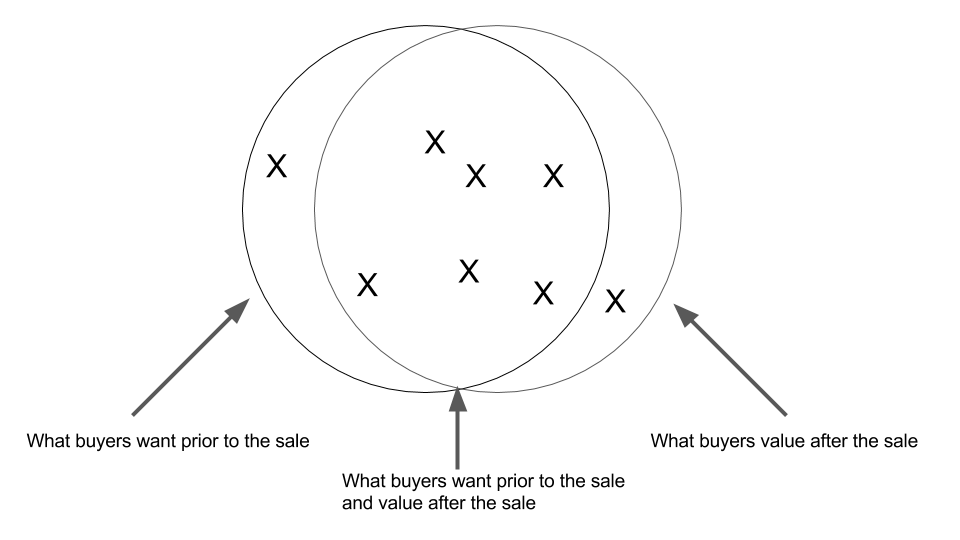
Advice to Dishonest Businesses
Being dishonest is easy - and that's no lie.My first piece of advice is to continue selling the sizzle and not the steak. Focus on functionality that doesn't cost much but attracts attention and cut out anything that isn't obvious to the average consumer.
Not sure which areas are wasted when selling to an uneducated consumer? Any features related to the following might be a great place to start:- Maintainability
- Usability
- Longevity
